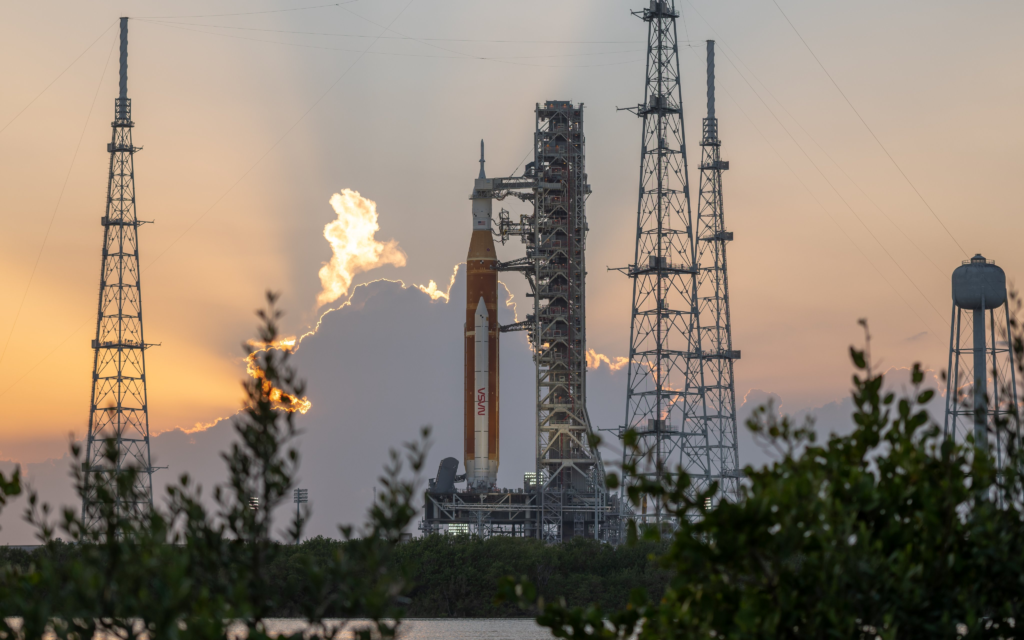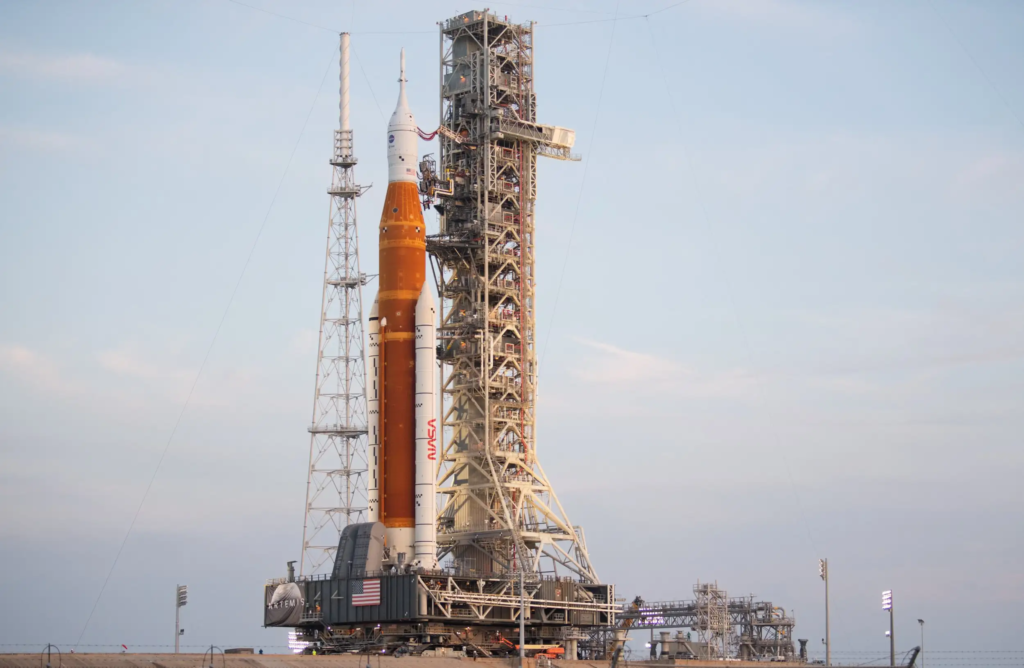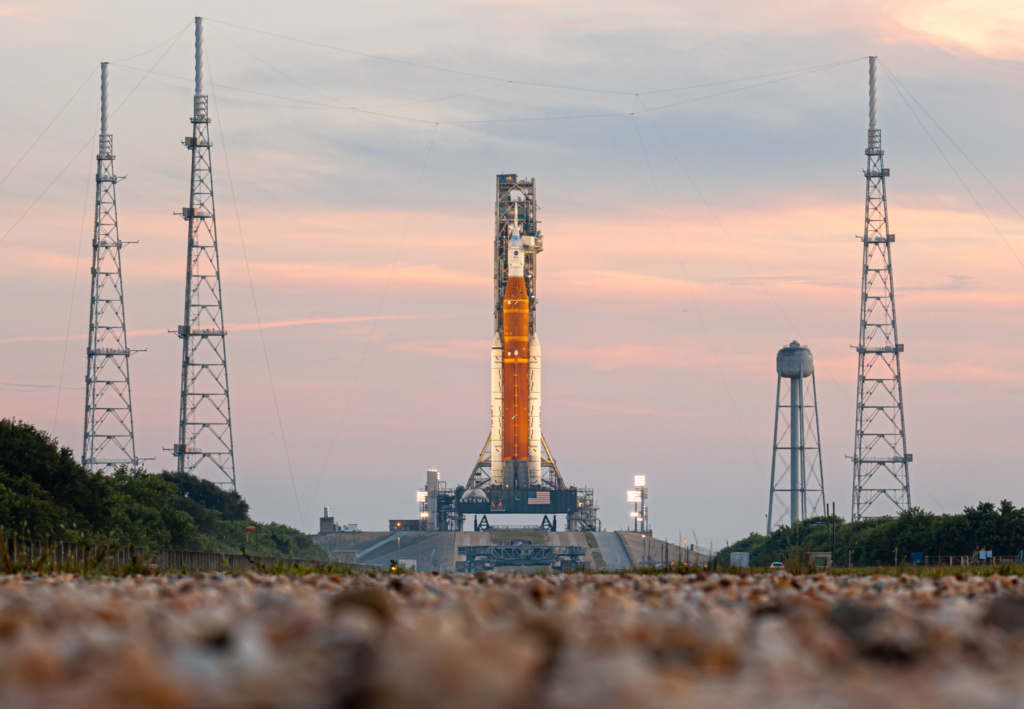
NASA Runs Into More Issues With The Space Launch System
The Space Launch System is intended to be NASA’s next-generation launch vehicle and the backbone of practically all future Artemis missions. One of the most powerful rockets in the world with years of work and billions of dollars behind it. This being said, the agency has run into somewhat frequent issues with the launch vehicle, going all the way back to the Wet Dress Rehearsal only months prior.
Yesterday marked the second launch attempt of Artemis 1. Unfortunately, a few different problems arose that brought the launch to a halt and officially sent the rocket back to the Vehicle Assembly Building. Specifically, a liquid hydrogen leak continues to stop NASA and the Space Launch System’s progress. This among other complications forced the agency to reconsider launch opportunities.
It’s important to point out that the Space Launch System has never been launched and complications are expected. NASA continues to make it clear that they are not going to launch SLS until they are 100% ready and confident in the mission. Here I will go more in-depth into yesterday’s launch attempt, what exactly went wrong, and NASA’s plan going forward.
Yesterday’s Attempt

It began around 5:30 a.m. when Artemis Launch Director Charlie Blackwell-Thompson gave the “go” to officially begin loading propellants into the Space Launch System rocket. During tanking operations, teams fuel the Space Launch System (SLS) rocket with liquid oxygen (LOX) and liquid hydrogen (LH2), beginning with the rocket’s core stage and then the interim cryogenic propulsion stage. Tanking begins with chilling down the LOX lines for the core stage. The process for the chill down, or cooling, uses the propellant lines to load the rocket’s core stage LOX in preparation for tanking. The LOX tank holds 196,000 gallons of liquid oxygen, cooled to minus 297 degrees Fahrenheit. In sequential fashion, LOX and LH2 will flow into the rocket’s core stage tank and be topped off and replenished as some of the cryogenic propellant boils off. The process involves slowly filling the core stage with propellant to thermally condition the tank until temperature and pressure are stable before beginning fast fill operations, which is when the tank is filled at a quicker pump speed. As the super cold liquid oxygen fills the core stage tank, some venting may be visible.
In addition to the beginning of propellant loading, weather conditions were estimated to be around 60% favorable in the morning and expected to increase to 80% later in the day. At the time, everything was looking promising for the launch of Artemis 1. Just before 7 a.m. Engineers had started the slow fill phase of loading super cold liquid oxygen into the Space Launch System rocket’s core stage. Unfortunately, only about 20 minutes after the start of this operation the agency ran into a problem. At 7:24 a.m. NASA reported that engineers detected a liquid hydrogen leak in a quick disconnect cavity and had stopped flowing the propellant to the core stage while they troubleshoot. To try and fix the issue, launch controllers attempted to warm up the quick disconnect to attempt to reseat it to get a tight seal. By 8 a.m. they had resumed the flow of liquid hydrogen to the core stage after warming up a quick disconnect in the engine section where a hydrogen leak was detected in the cavity between the ground and flight side plates of the quick disconnect. However, this quick fix wasn’t successful and as engineers increased the pressure on the flow of liquid hydrogen into the core stage, a leak reoccurred. From here they tried to fix the issue again by stopping the flow of liquid hydrogen to the tank, closing the valve used to fill and drain it, then increasing pressure on a ground transfer line using helium to try to reseal it. Once complete they tried again only for the leak to reoccur. After this third leak, the agency tried some of the same quick fixes that I just highlighted prior. Finally, after the liquid hydrogen leak continued for a fourth time, they officially scrubbed the launch.
In a report made soon after the scrub, the agency stated, “After standing down on today’s Artemis I launch attempt when engineers could not overcome a hydrogen leak in a quick disconnect, an interface between the liquid hydrogen fuel feed line and the Space Launch System (SLS) rocket, mission managers met and decided they will forego additional launch attempts in early September. Over the next several days, teams will establish access to the area of the leak at Launch Pad 39B, and in parallel conduct a schedule assessment to provide additional data that will inform a decision on whether to perform work to replace a seal either at the pad, where it can be tested under cryogenic conditions, or inside the Vehicle Assembly Building. Either way, in order to meet the requirement by the Eastern Range for the certification on the flight termination system, currently set at 25 days, NASA will need to roll the rocket and spacecraft back to the VAB before the next launch attempt to reset the system’s batteries.
NASA clarified that during yesterday’s launch attempt, engineers saw a leak in a cavity between the ground side and rocket side plates surrounding an 8-inch line used to fill and drain liquid hydrogen from the SLS rocket. Three attempts at reseating the seal were unsuccessful. While in an early phase of hydrogen loading operations called chilldown, an inadvertent command was sent that temporarily raised the pressure in the system. While the rocket remained safe and it is too early to tell whether the bump in pressurization contributed to the cause of the leaky seal, engineers are examining the issue.
NASA’s Plan

Now that we know more about exactly what went wrong on yesterday’s attempt, we can take a closer look at the agency’s plan going forward. Starting with heading back to the Vehicle Assembly Building. While this is required in order to recharge batteries and follow guidelines, this is likely the best case for SLS. Once in the VAB engineers can work on the problem and try and ensure everything is fixed prior to the next attempt. Looking at the first launch attempt in late August, it was scrubbed due to a liquid hydrogen leak only for the same thing to happen days later on the second attempt. The extra time and placement of the rocket will ideally give the agency time to fix this reoccurring issue.
The next thing everyone wants to know is when will the next launch attempt be. In reality, the soonest we could see SLS back on the pad and ready to launch is September 19th. This is due to the fact that there are a few major considerations and requirements when launching to the Moon. First, the launch day must account for the Moon’s position in its lunar cycle so that the SLS rocket’s upper stage can time the trans-lunar injection burn with enough performance to successfully intercept the “on ramp” for the lunar distant retrograde orbit. Second, the resulting trajectory for a given day must ensure Orion is not in darkness for more than 90 minutes at a time so that the solar array wings can receive and convert sunlight to electricity and the spacecraft can maintain an optimal temperature range. This constraint requires knowledge of the Earth, Moon, and Sun along the planned mission trajectory path before the mission ever occurs, as well as an understanding of the Orion spacecraft’s battery state of charge before entering an eclipse. Third, the launch date must support a trajectory that allows for the skip entry technique planned during Orion’s return to Earth. A skip entry is a maneuver in which the spacecraft dips into the upper part of Earth’s atmosphere and uses that atmosphere, along with the lift of the capsule, to simultaneously slow down and skip back out of the atmosphere, then reenter for final descent and splashdown. The technique allows engineers to pinpoint Orion’s splashdown location and on future missions will help lower the aerodynamic breaking loads astronauts inside the spacecraft will experience, and maintain the spacecraft’s structural loads within design limits. Finally, the launch date must support daylight conditions for Orion’s splashdown to initially assist recovery personnel when they locate, secure, and retrieve the spacecraft from the Pacific Ocean. These four requirements force the agency to set specific dates that SLS can launch.
The Space Launch System is in the first available launch period right now that goes from August 23rd, to September 6th. Since we know NASA will not be ready in just two days, this pushes the mission back to the next launch period. The next period starts on September 19th and goes to October 4th with exceptions on the 29th and 30th. This means that the soonest we will see SLS lift off would be the 19th if everything goes according to plan. However, NASA has a few complications they need to fix along with general operations back in the VAB. All of which will impact the launch of Artemis 1.
Conclusion
NASA has been trying to launch the Space Launch System for a couple of days now. The first and most recent attempt was scrubbed due to similar issues. Now the rocket has missed the initial launch period and is headed back to the VAB. We will have to wait and see how it progresses and the impact it has on the space industry.
